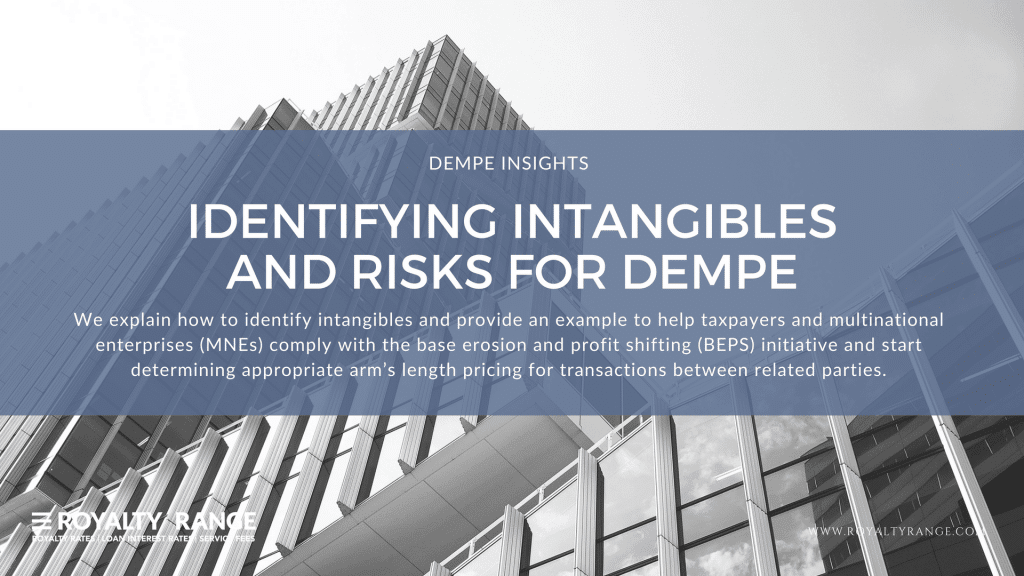Identifying intangibles and risks for DEMPE
July 12, 2018

In the 2017 edition of the Transfer Pricing Guidelines, the Organisation for Economic Co-operation and Development (OECD) outlines six steps for analyzing transactions involving intangibles. Step 1 is to “Identify the intangibles used or transferred in the transaction with specificity and the specific, economically significant risks associated with the development, enhancement, maintenance, protection, and exploitation of the intangibles” (6.34). Below, we explain Step 1 and provide an example to help taxpayers and multinational enterprises (MNEs) comply with the base erosion and profit shifting (BEPS) initiative and start determining appropriate arm’s length pricing for transactions between related parties.
Identifying intangibles for transfer pricing purposes
The Transfer Pricing Guidelines discusses how to identify intangibles for the purposes of transfer pricing. It defines ‘intangible’ as “something which is not a physical asset or a financial asset, which is capable of being owned or controlled for use in commercial activities, and whose use or transfer would be compensated had it occurred in a transaction between independent parties in comparable circumstances” (6.6). The Transfer Pricing Guidelines state that analyses of transactions involving intangibles should focus on “the determination of the conditions that would be agreed upon between independent parties for a comparable transaction”.
Conditions for intangibles
Intangibles that are important for transfer pricing may not necessarily be recognized as intangibles for accounting or legal purposes (6.7). Say that an intangible is created through internal advertising activities. The costs associated with the advertising activities might be treated as expenses for accounting purposes, and so the resulting intangibles may not be seen as company assets. However, if the intangibles are used to generate income for the business, they will need to be considered when conducting a transfer pricing analysis. It is also the case that a group of intangibles can generate economic value when exploited together – something that may not matter for accounting but that is key for transfer pricing.
Another consideration to make when identifying intangibles for transfer pricing is whether the value of an item and the returns it generates are affected by protection (contractual, legal or other) (6.8). Taxpayers should also consider the relevancy of any intangibles that have been transferred as part of a group of business assets. While these two factors (protection and separate transferability) should be considered when carrying out a transfer pricing analysis, they are not necessary conditions for characterizing items as intangibles.
As Paragraph 6.9 states, intangibles should be distinguished from “market conditions or local market circumstances”. Such factors cannot be owned or controlled, and the OECD’s definition of ‘intangible’ is something “which is capable of being owned or controlled for use in commercial activities”. They should, however, be considered for comparability analyses.
It is also worth noting that, just because an item is identified as an intangible, this does not mean that returns should be allocated for its use or transfer (beyond the standard payment that is required for all goods and services). The OECD gives the example of an enterprise offering a service using non-unique know-how. While know-how is classed as an intangible, the fact that comparable know-how is used by other service providers means that the use of this non-unique intangible does not warrant extra returns being allocated to the enterprise.
OECD highlights the importance of accuracy, relevancy and specificity in terms of identifying intangibles. By means of a functional analysis, taxpayers and MNEs must first identify the relevant intangibles and determine how they contribute to value creation for the transaction in question. They have to highlight the functions performed and risks assumed in relation to the development, enhancement, maintenance, protection and exploitation (DEMPE) of the intangibles. They must also classify how the intangibles in question interact with other intangibles, tangible assets and business operations to create value. A thorough functional analysis is essential to determining arm’s length pricing conditions.
Identifying specific, economically significant risks for DEMPE
The second part of Step 1 is to identify the “specific, economically significant risks associated with the development, enhancement, maintenance, protection, and exploitation of the intangibles” (6.34). Advice for this is outlined in the Transfer Pricing Guidelines, which define ‘risk’ as “the effect of uncertainty on the objectives of the business” (1.71), reflecting the inherent risk that comes with exploiting opportunities, spending money or generating income. Risk and opportunity are linked, and companies focus on putting risk mitigation strategies in place to ensure that business opportunities result in the desired rate of return. The downside of risk is that the anticipated result of the opportunity may not materialize. Risk is an inherent part of business. Companies can mitigate the impact of economically significant risks by identifying and managing them in order to boost returns (e.g. with product strategy, knowledge of changing market trends and creation of demand). They should identify the significance of the risk by determining how likely it is that the risk will result in profits or losses for the company, and how large these profits or losses will be.
The OECD gives the examples of a consumer goods company introducing a different flavor, and a medical company implementing a new healthcare treatment. A new product flavor is unlikely to influence the long-term reputation of a company, and the costs of creating and marketing it would be relatively low. However, a new healthcare treatment could significantly affect the medical company’s reputation, and substantial costs would be required in terms of strategic decisions and investment at each stage of the treatment’s journey to market.
Categories of risk
There are various sources of uncertainty within business operations that can result in risk. The OECD outlines the following list, which is neither ordered nor categorized. The list is intended to provide a framework that may assist in ensuring that a transfer pricing analysis considers the range of risks likely to arise from the commercial or financial relations of the associated enterprises, and from the context in which those relations take place.
- Strategic or marketplace risks – e.g. marketplace trends, new geographical markets and concentration of development investment.
- Infrastructure or operational risks – e.g. bringing a product to market on time, meeting demand and producing products to a high enough standard.
- Financial risks – e.g. managing liquidity and cashflow, financial capacity and creditworthiness.
- Transactional risks – e.g. pricing and payment terms in commercial transactions.
- Hazard risks – e.g. accidents and natural disasters.
Analyzing risk with comparables data
Taxpayers and MNEs need to assess the economic significance of the risks they have identified and determine how the risks affect the pricing of transactions involving intangibles. This is part of the functional analysis for assessing value creation, profitable activities and the economically relevant features of transactions. Based on that, comparability can be assessed by seeing if potentially comparable transactions include equal levels of risk.
The OECD uses the example of a multinational toy retailer to highlight the economic significance of risk. The retailer buys its products from multiple third-party manufacturers. With the majority of sales focused on November and December, there is risk involved in buying strategically and determining which products (and how many of them) will sell. This buying risk requires local market expertise to mitigate it. The risk is greater if the retailer and third-party manufacturer agree to a period of exclusivity for a particular product.
In line with Paragraph 1.76, the parties that have control over a specific risk in a transaction are the ones that made decisions relating to that risk. In an MNE group other parties may also be involved in setting the risk management policies. This includes setting policies for the assumption and control of specific risks – e.g. the group may set the level of risk that it is willing to accept for the exploitation of the intangible, and other departments may assess the risk and administer controls and processes to manage, mitigate and influence the risk. This risk management needs to be ongoing so that the risk achieves the required returns.
Accessing OECD-compliant data for transfer pricing
The RoyaltyRange database is specially designed to provide taxpayers and MNEs with the high-quality data they need to analyze transactions involving intangibles. Our third-party, publicly available, OECD-compliant data can help you complete Step 1 of the OECD’s six-step framework for analyzing transactions involving intangibles. You will also be able to find in-depth analyses of Steps 2, 3, 4, 5 and 6 on the RoyaltyRange blog page in due course.
You can use this text with reference to RoyaltyRange website.
Request One Search
We will perform the search and deliver the initial results within hours, at no cost.




